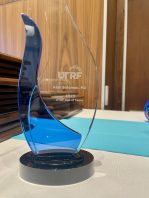
Alan Solomon inducted into UT Research Foundation’s Hall of Fame
The longtime Physician Scientist was recognizes for the impact of his work on multiple myeloma and amyloidosis over decades.
Dr. Alan Solomon is not a household name for many individuals, but the impact of his work as a combination Physician Scientist on multiple myeloma and amyloidosis over decades cannot be understated.
 And those professional accomplishments were recognized on Thursday when the University of Tennessee Research Foundation (UTRF) honored Solomon by inducting him into the UTRF Hall of Fame. According to Maha Krishnamurthy, UTRF President, he’s only the third person so recognized, joining the late David Millhorn, UT Executive Vice President and Vice President for Research, Economic Development and Outreach, and Peter Tsai, the UT, Knoxville faculty member who invented the technology used in N95 respirators and came out of retirement to help companies seeking to produce his charged nonwoven fabric or scale-up their production.
And those professional accomplishments were recognized on Thursday when the University of Tennessee Research Foundation (UTRF) honored Solomon by inducting him into the UTRF Hall of Fame. According to Maha Krishnamurthy, UTRF President, he’s only the third person so recognized, joining the late David Millhorn, UT Executive Vice President and Vice President for Research, Economic Development and Outreach, and Peter Tsai, the UT, Knoxville faculty member who invented the technology used in N95 respirators and came out of retirement to help companies seeking to produce his charged nonwoven fabric or scale-up their production.
Ahead of that recognition, we had the opportunity recently to interview Solomon, the 90-year-old longtime Professor at the UT Graduate School of Medicine, now retired for a decade, about his lifetime of work to make the lives of individuals better. That not only includes his contributions to scientific discovery and healthcare, but also roles that Solomon played in the community including chairing the committee that built the Knoxville Museum of Art and helping build the Visitor’s Center at the Knoxville Botanical Garden and Arboretum.
For those not familiar with amyloidosis, Solomon explains that it is a disorder where normally soluble proteins, because of certain chemical features, turn into insoluble, virtually indestructible fibrils termed amyloid. They can be found in various body organs – heart, kidneys, liver and brain, and the most common one – designated as Abeta – is present in the brain of those with Alzheimer’s disease.
After graduating from the Duke University School of Medicine and completing Fellowships at the National Cancer Institute and Rockefeller Institute, Solomon arrived in Knoxville in 1966 as an Associate Research Professor at the then named UT Memorial Research Center and Hospital.
It was nearly three decades later when he was attending an amyloid-focused conference in Copper Mountain, CO in 1995 that he had one of those truly breakthrough moments. Solomon told us that it occurred during the final afternoon of the five-day conference when the presentation was focused on AL amyloidosis, a disease akin to multiple myeloma, where the only treatment was chemotherapy.
“Although this allegedly slowed the progression of the disease, unfortunately, the pathologic deposits (of amyloid fibrils) would remain or progress, resulting eventually in the patient’s death,” Solomon explained. “While listening to those presentations, I was struck by the thought that my research efforts should be focused on a means to eliminate this inert material” from the body.
He immediately called his junior associate in Knoxville and asked him to inject under the skin of a laboratory mouse afflicted with amyloidosis some amyloid fibrils that had been surgically extracted from the spleen of a patient. “I was most curious to know how the animal could effectively remove the material,” Solomon said.
The answer came 14 days later when the large bump on the mouse’s back, referred to as an amyloidoma, was gone. They next demonstrated that removal of the amyloid was dependent upon a series of events that began with the mouse’s generation of an anti-amyloid antibody and its binding to the amyloidoma which, in turn, attracted an army of white blood cells that resulted in the dissolving of the amyloid fibrils.
This caused Solomon to explore if any on the monoclonal anti-light chain antibodies that had been generated in mice for a different purpose would, by chance, react specifically with amyloid fibrils. “Fortuitously, we discovered that one such antibody, designated 11-1F4, did so,” he said.
Solomon drew on something he had learned during his time at the Rockefeller Institute, namely that to obtain a more potent antiserum to a protein, it should be denatured first by heating the material. That was what he did with the patient’s protein that he had injected into the mouse.
“It unknowingly changed it into amyloid fibrils,” Solomon explained. “Thus, by good fortune, I had inadvertently obtained an anti-amyloid fibril antiserum. In subsequent experiments, when mice bearing human amyloidimas were given a series of injections of 11-1F4, the material disappeared not in 14 days but in seven.”
For the clinical investigator, the goal was to “translate” this discovery by bringing it from the laboratory to the patient.
NEXT: The journey had just begun.
Like what you've read?
Forward to a friend!

